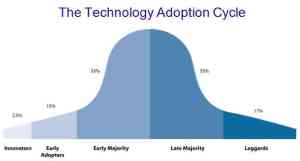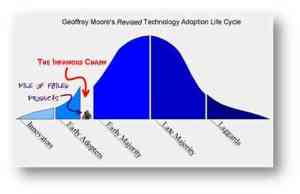This is another in a series of reviews on management & leadership books that I’m doing on the blog.
Geoffrey Moore wrote his seminal product development book, Crossing the Chasm, back in 1991. That was eight to ten years before the first dot-com bubble. Now, if only entrepreneurs in those heady days of pets.com had read this book, just think of how much capital, venture and otherwise, might have been preserved. Moore’s lessons are still extremely relevant nearly a generation later, and indeed, I see many companies making the same mistakes in product development & execution that he describes here. As such, the book should be required reading for any senior engineer, product manager, or product marketing person. This last group was initially the target audience for the book.
I could not read more than five pages in this book without wanting to tear out one of its pages — somewhat difficult with an e-book, admittedly — and march over to one of my colleagues’ desks, vehemently pointing at the crumpled page (also somewhat difficult for someone who works from home). “Look, this is what I’ve been saying all along,” I could imagine myself shouting. “Geoffrey Moore says the same thing too, and he’s got a track record to back it up!” In that way, Moore is like the Aimee Mann of product development: he’s written down all the things that you’d ever thought about, but in a more concise and powerful way.
Where do I start with the ‘lessons learned’ from this book, to encourage you to read it? I suppose I should at least explain “the chasm”. Simply put, you can think of the technology adoption lifecycle as being a normal distribution, with four main groups: the early adopters, the early majority, the late majority, and the skeptics. The following diagram illustrates this. One can imagine the gap between the early adopters and the early majority as being one standard deviation from the mean, and the same for the gap between the late majority and the skeptics.
Moore’s central thesis is that rather than product adoption being a continuous function along the normal distribution, it is, instead, a discontinuous function; the gaps between the adopters is actually quite large. This is represented in the second diagram; the large discontinuity between the early adopters and the early majority is known as the chasm, when you are trying to refocus & reframe your product to target the early majority, rather than those enthusiasts who have been with you since the beginning. During the time when you are crossing the chasm, you are extremely vulnerable, financially speaking; sales growth is sluggish if not flat, and yet you are burning product development dollars. It is crucial for a product’s survival, therefore, to cross the chasm as quickly as possible.
How do you do this? Well, obviously, that’s what the whole book is about: it lays out a methodology for conquering the mass market. But one of the main strategies that really stuck with me is the need to establish a beachhead in the early majority, and use that as an anchor by which to cross the chasm, just as in war; think of the D-Day invasion of the beaches of Normandy that ultimately led to the Allies conquering Europe. That beachhead market segment has to be narrowly defined, using a very disciplined, methodical process. You only get one shot at it, so it had better be good.
Another important concept that distinguishes the early adopters from the early majority is that the latter demand a “whole product solution” – this is analogous to the ‘solution selling’ mentioned in The Challenger Sale. Mainstream customers expect external integrations, use cases, documentation, and so on; in short, they expect a complete solution, not just a bunch of code that solves a point problem. This, in my mind, is what differentiates product from software. Software is an important component of product, but it isn’t the only component.
Moore also talks about how to manage the expectations of early adopter customers, who can help provide valuable product feedback at the expense of sometimes working on their use cases to the end of time. That’s because they see early adoption of new technology as a competitive advantage and want to make it their own, whereas you are trying to make new technology generic for all customers, particularly those who will buy. In order to manage these early customers effectively, strong account management is required. Admittedly, in some of our product development at Chef, we’ve not succeeded in doing so, and we’ve wound up in deep rabbit holes with very enthusiastic customers but whose use cases are very specific to their environment.
In the last chapter, Moore talks about personnel management and particularly how to compensate/treat the pioneer technologists (initial developers) who have shed blood, sweat and tears to get your initial product out. The general wisdom and practices in our field are to compensate them with long-term equity (options) when you cannot pay them market rate, initially. Moore takes an interesting contrarian approach, and I’ll quote him directly:
“They can point with accuracy to the notion that they created a large part of the core product. Thus, should that product become a mainstream hit, they feel they should get a major share of the gains. The fact is, they don’t, and the truth is, bluntly, they don’t deserve it, either. Mainstream success… is a function of the whole product, not the core product, and that is a very large team effort indeed.”
“What pioneer technologists do have a right to is a larger share of the early market returns, because here it truly is the core product that drives success. The problem is that cash is typically so tight during this period, there is none to throw off in the form of a reward. So equity is the usual fallback. This is a compromise, to say the least, as equity should be reserved for people who cross the chasm and stay – not the pioneers’ ideal role, but still a more frequent occurrence than them leaving the company.”
There is much more useful advice in this book than I can share in a simple review. My only complaint is that it started to drag in the last third of the book as Moore delved into specific details about product marketing that I (as a non-practitioner) do not yet understand. Perhaps down the road it’ll be more useful to me, but I missed the crisp, concise general advice of the first part of the book. Other than that, as I said, it is a recommended read for anyone building products, or trying to transition those products to the mainstream.



Talk about a laggard, I’m sold and I just hit the checkout counter. Great article you wrote there.